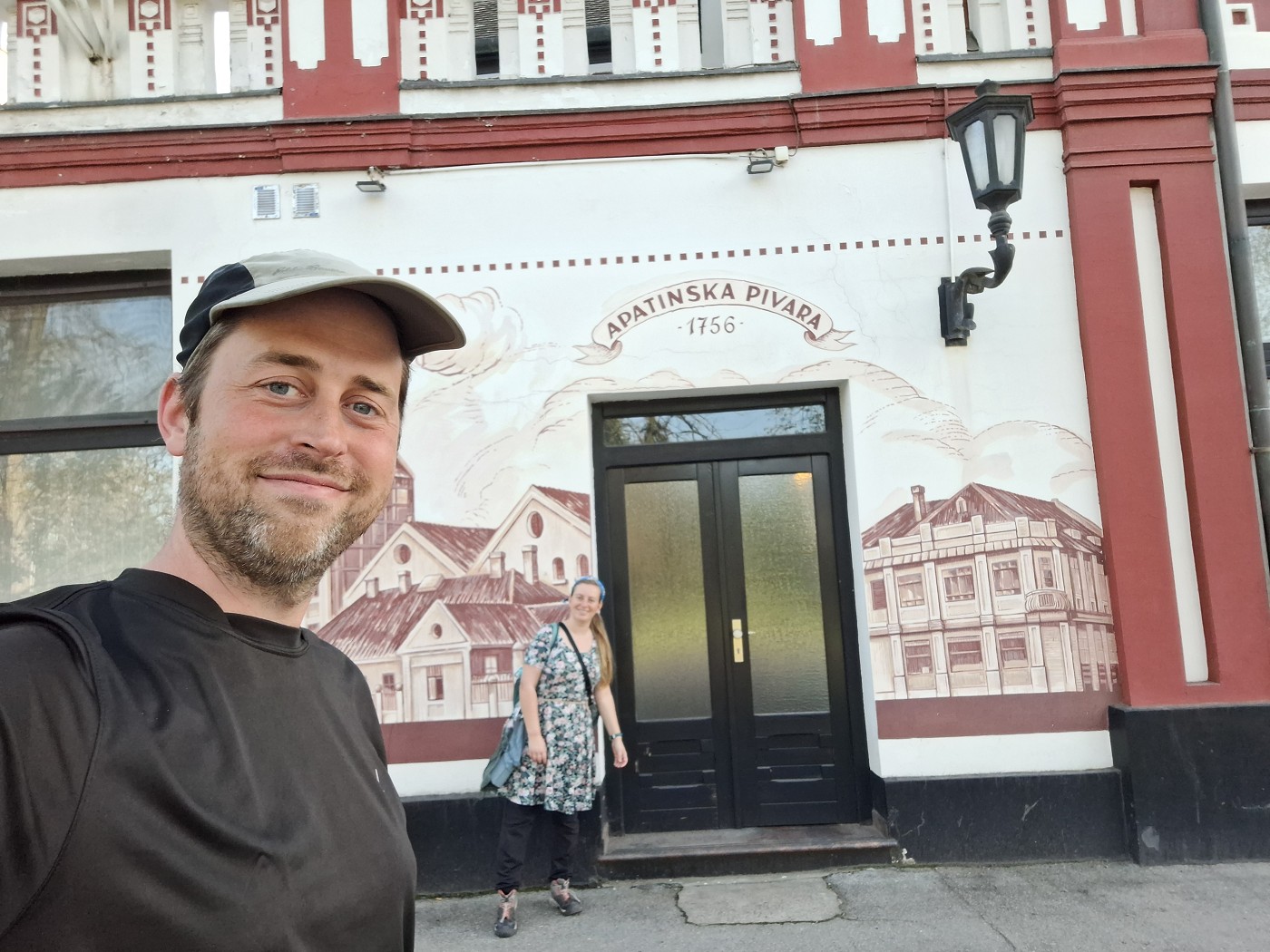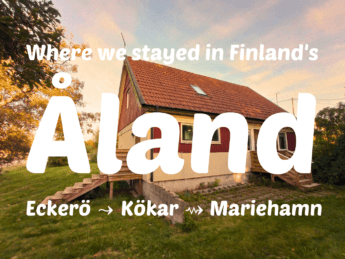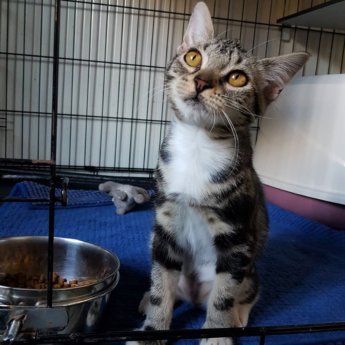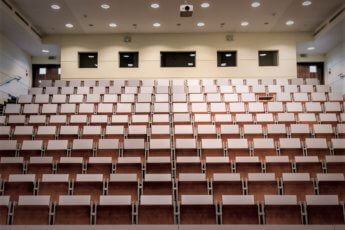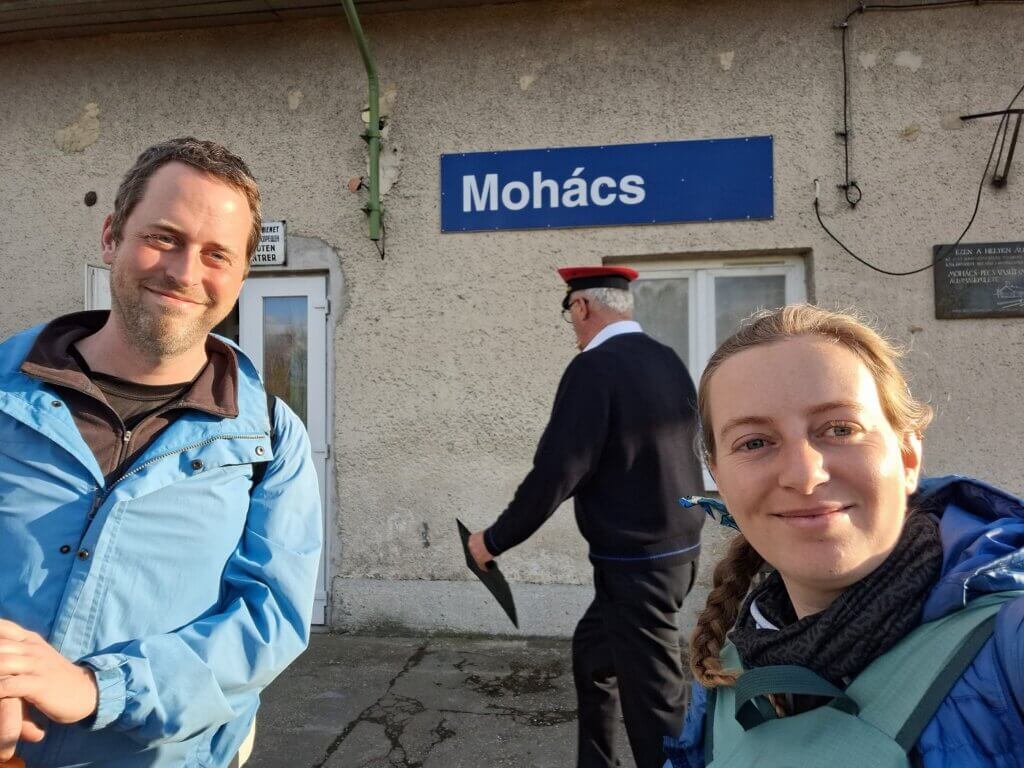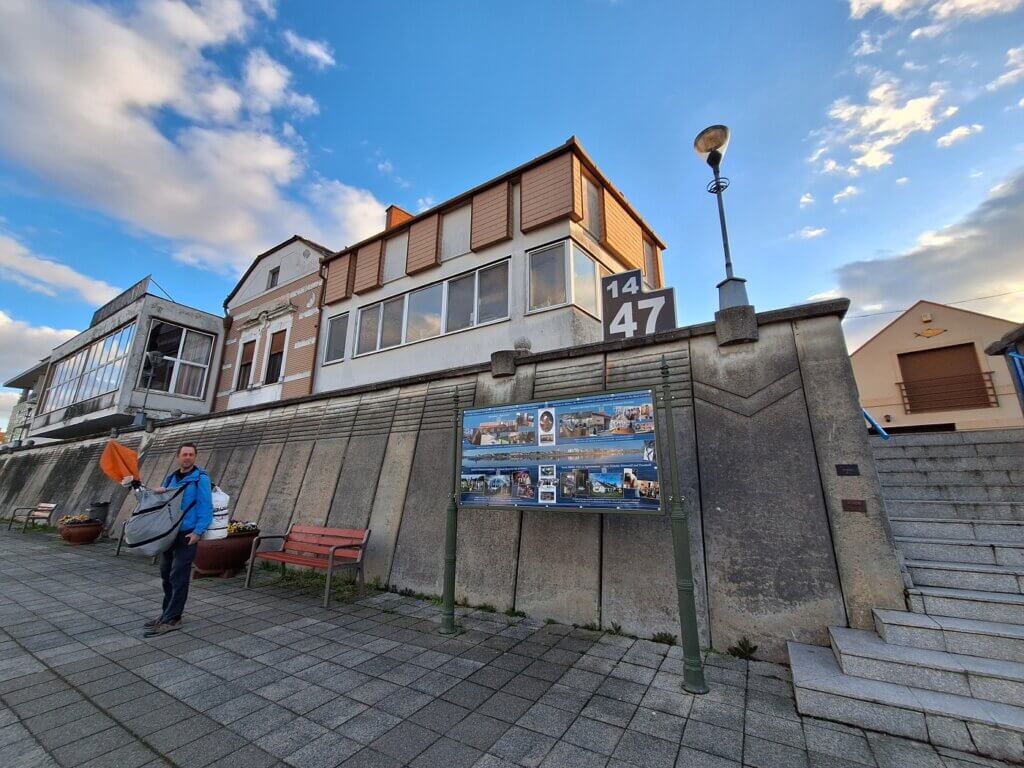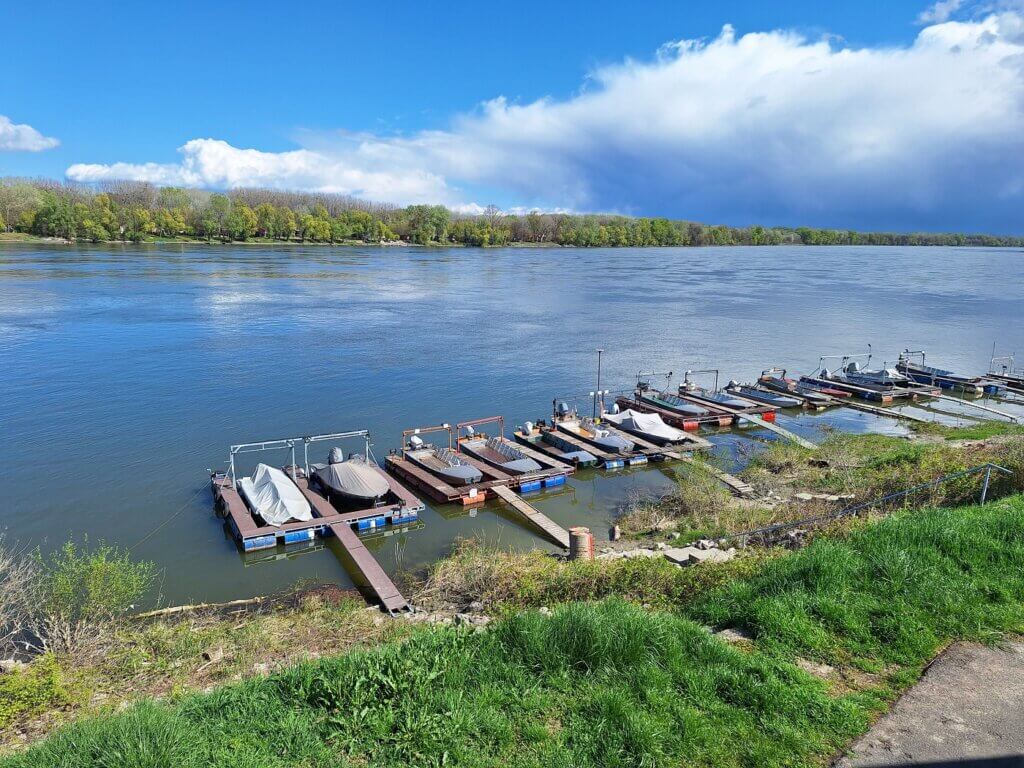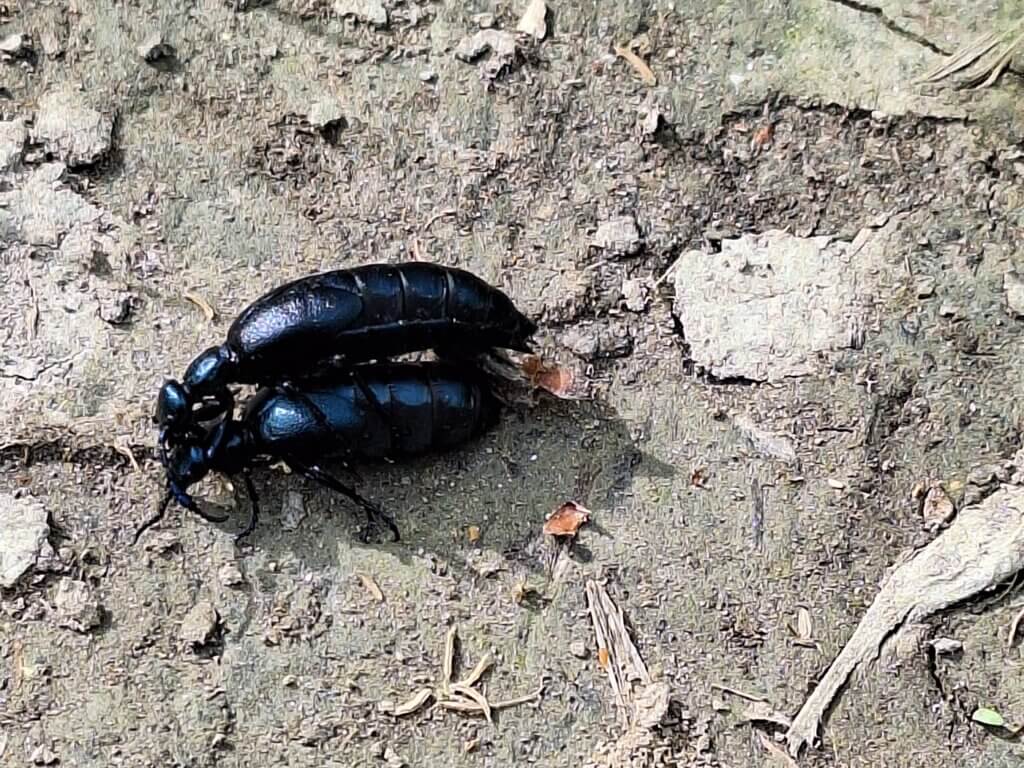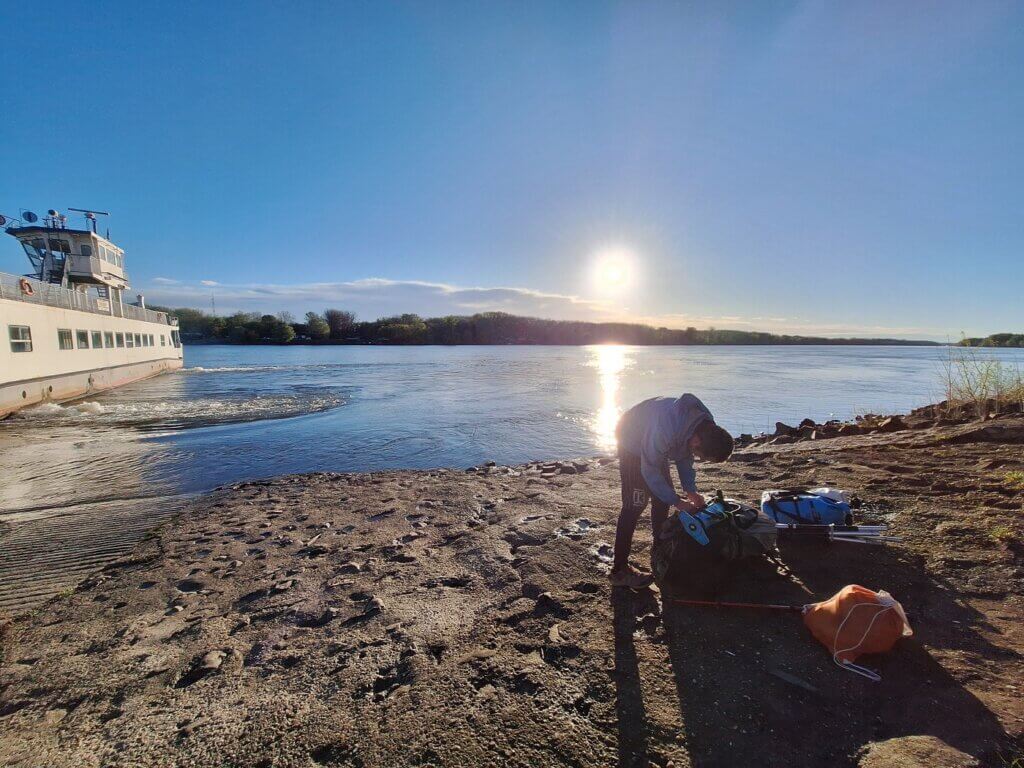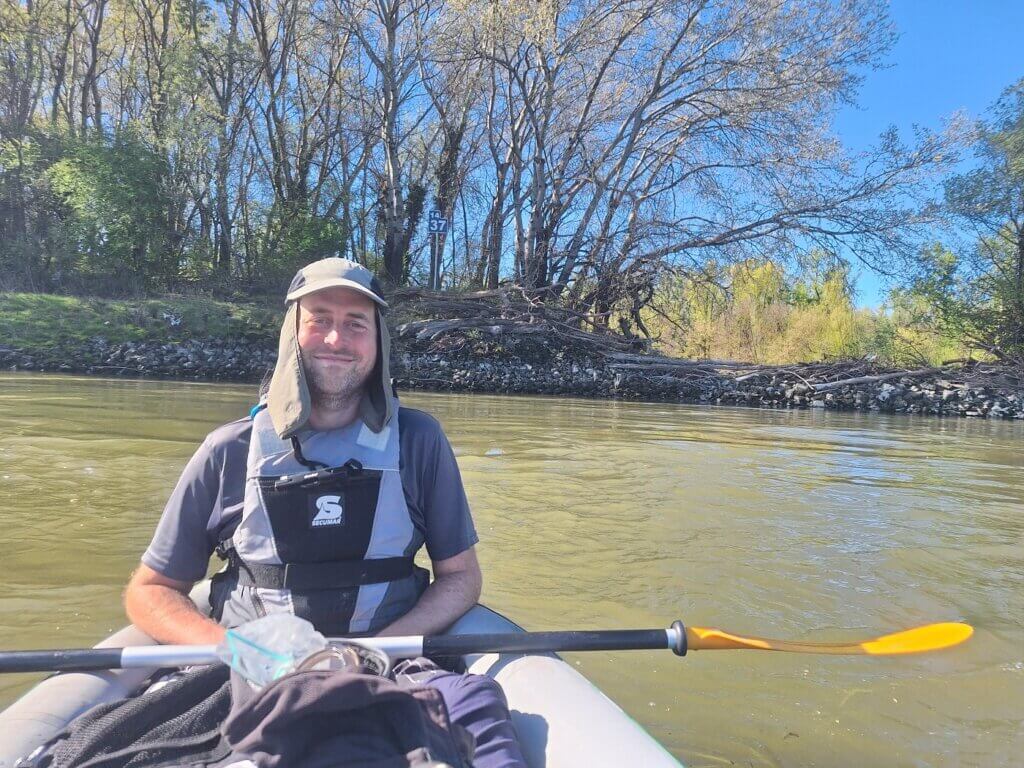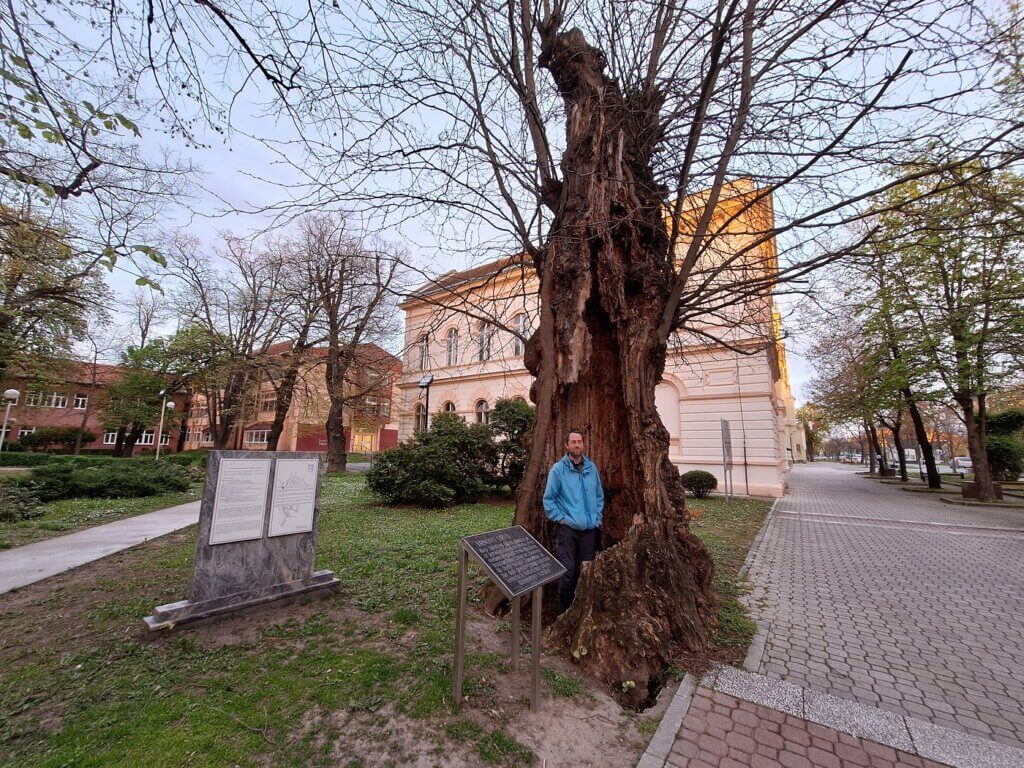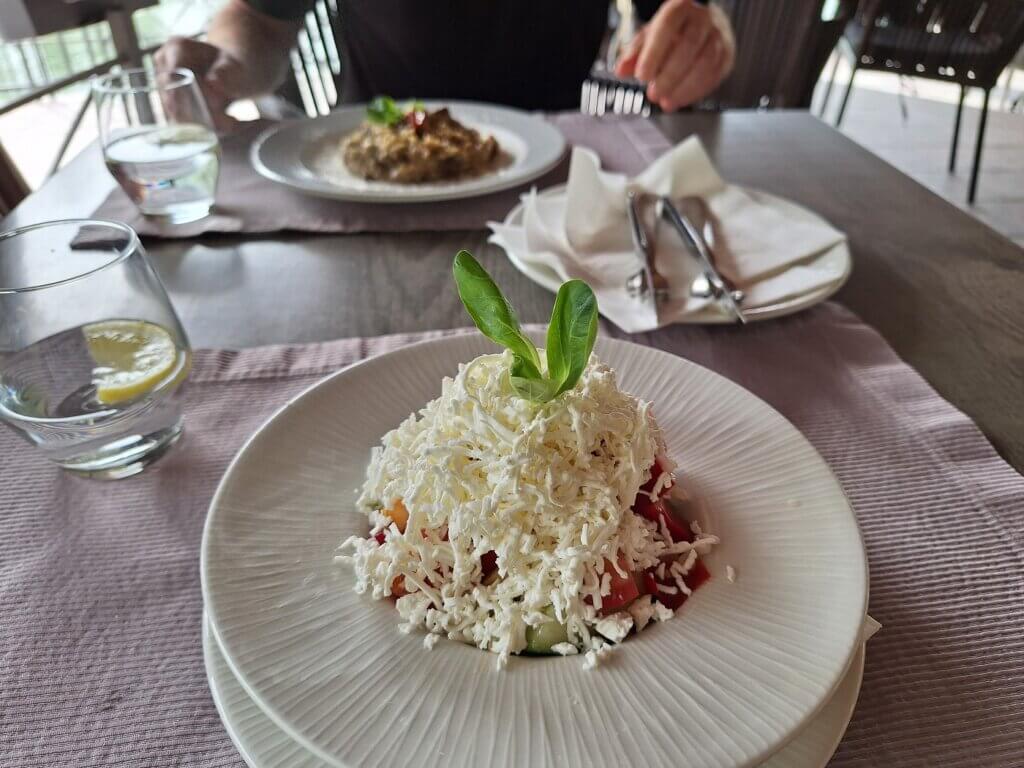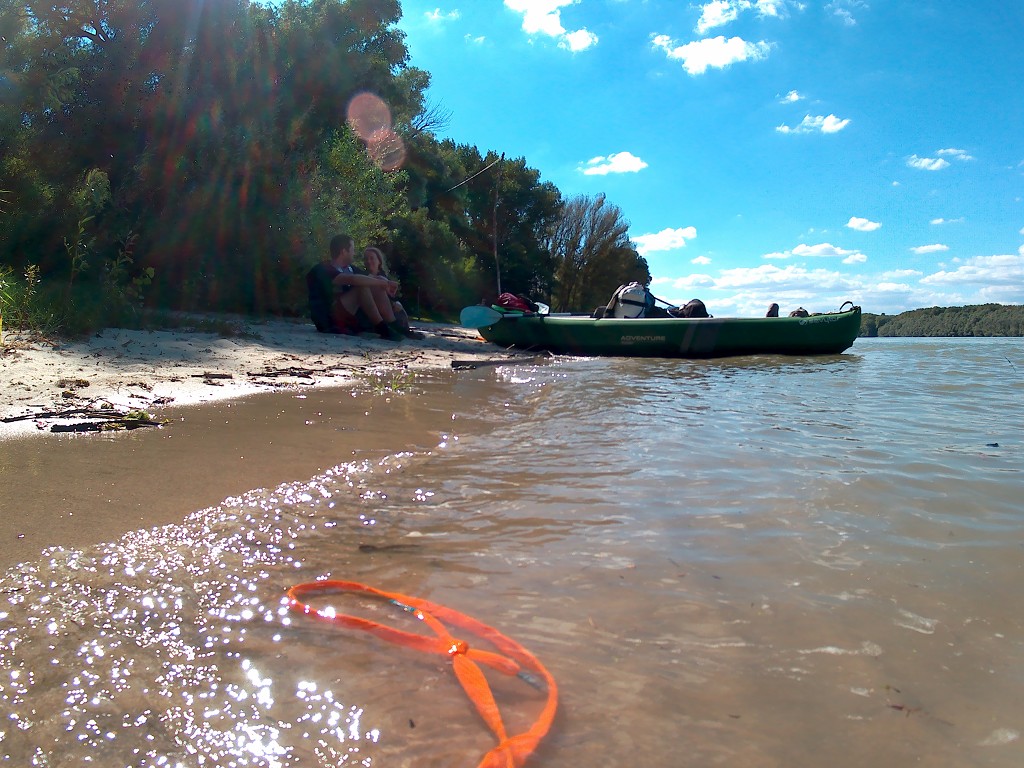
The events in this story happened on Thursday the 28th of March, 2024. We paddled our inflatable canoe Zucchini from Mohács in Hungary to Apatin in Serbia. This was our first kayaking day down the Danube of 2024 and a continuation of this trip in 2019. We intend to paddle to the Black Sea in 2024 this year. Since we’re crossing from a Schengen country to outside of the EU, this required some paperwork at the police.
Want to travel the (entire) Danube River in an adventurous way? Join our Facebook group Danube River Source to Sea: Kayak / Canoe / Bike / Hike / Sail to find your community
Contents
- 1 Our (Second) Stay in Mohács
- 2 Hungarian Immigration + A Call with a TID Participant
- 3 Leaving Mohács for Apatin: Day 50 or Day 1?
- 3.1 Inflating Zucchini at the Ferry Slipway
- 3.2 Kayaking to the Triple Border on the Danube: Hungary, Croatia, Serbia
- 3.3 Crossing the Danube in Wind and Waves at Batina and Bezdan
- 3.4 Serbian Immigration at Bezdan: Papers, Please
- 3.5 The Strongest Headwind + Lunch at Daraži Fok
- 3.6 Liberland Spotting
- 3.7 The Long Paddle to Apatin
- 3.8 Packing up Zucchini + Arriving at the Apartment in Apatin
- 4 Our Stay in Apatin
- 5 Found the information useful? Consider making a donation
- 6 Thank You for Rejoining Our Adventure!
Our (Second) Stay in Mohács
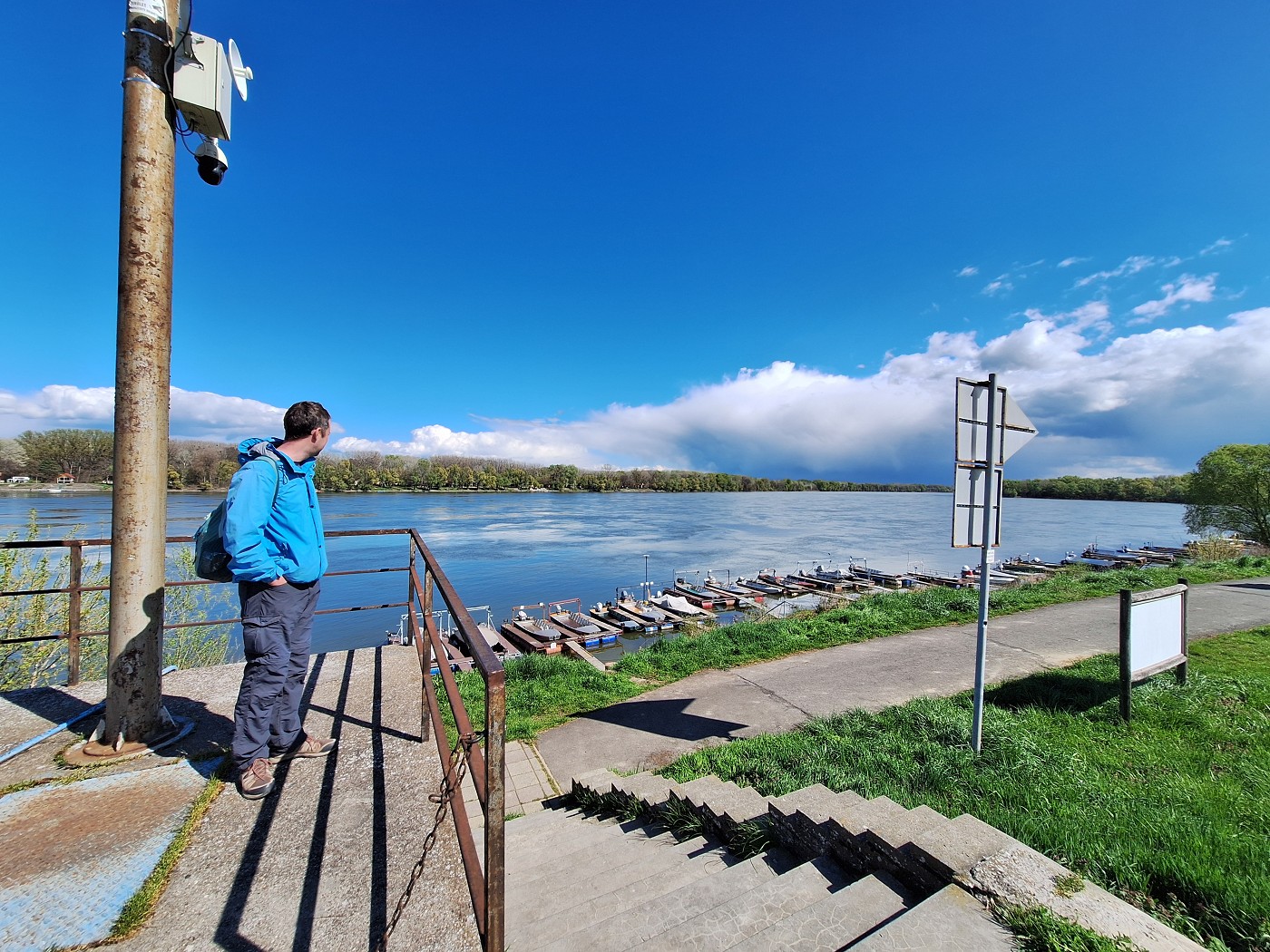
Hungarian Immigration + A Call with a TID Participant
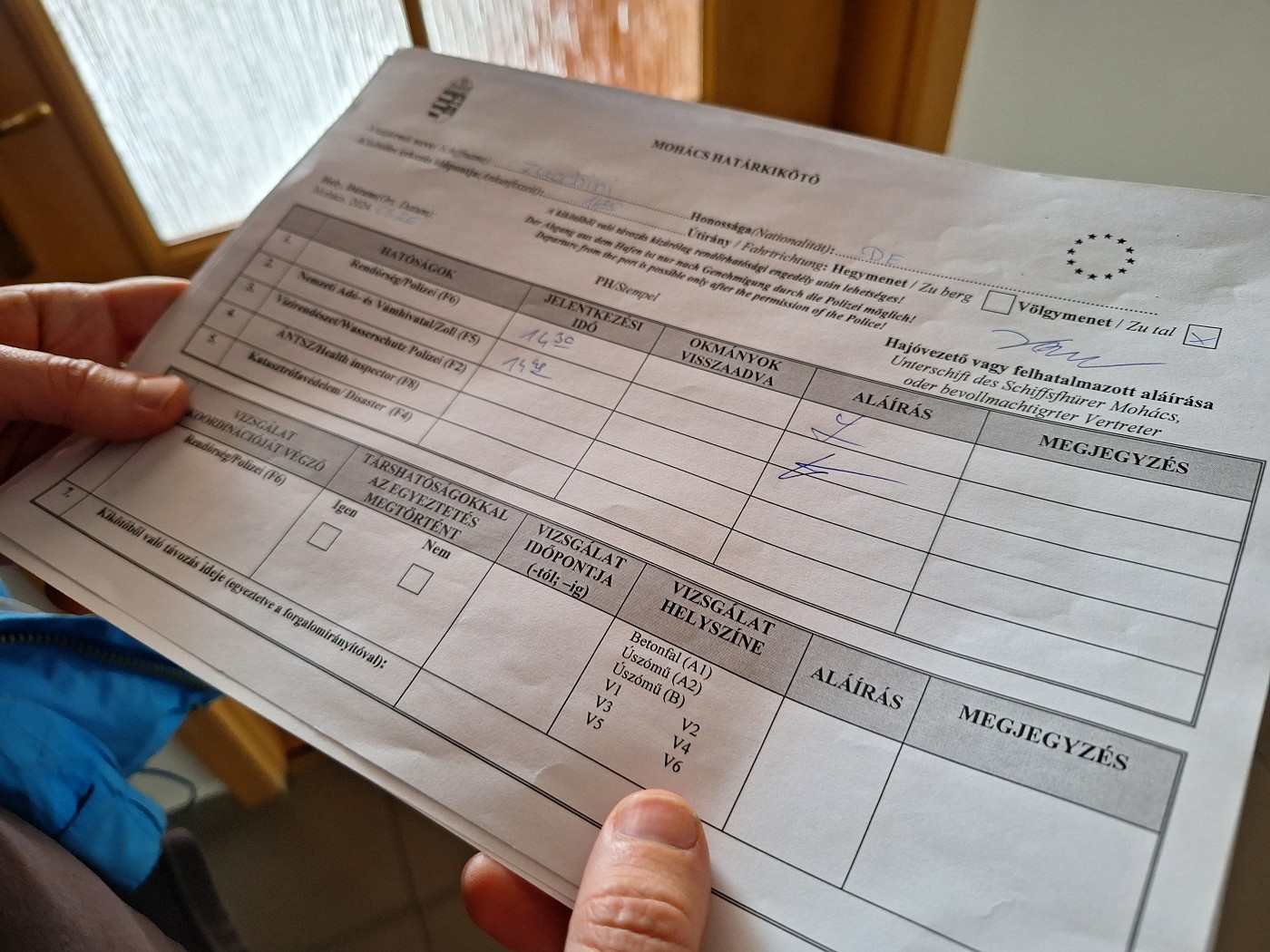
Leaving Mohács for Apatin: Day 50 or Day 1?

Inflating Zucchini at the Ferry Slipway
As I predicted, I didn’t catch any sleep. The alarm rang at 5:30 and I was ready to roll out of bed. Without coffee, we readied ourselves and finished packing. We carried everything out, gave the Mini Apartman one last check, and dropped off the key.
It was so sunny out the door and there was a surprising amount of people out and about for the time of day. We walked to the Mohács ferry as it was about to leave. The cars and pedestrians boarded the boat and we sailed across to Újmohács at 6:30. There was ample space for the both of us to coexist. But so far, it was unclear to most people what we were about to do.
We rolled out and inflated Zucchini. She smelled like hot garbage as we hadn’t dried her completely in the sun after arriving in Zagreb. Thankfully, we did not forget to put in the fin. That was a big fear of mine after it took us three paddle days to get into that habit back in 2019.
The Mohács ferry quickly returned as we changed into our kayak shoes and assembled the paddles. People walked and rolled off the boat, looking at what we were doing. One guy gave his thumbs up. I don’t think the ferry employees minded that we were using their infrastructure. One of the ferrymen also nodded in approval. And the ferry slipway was a lot better than our landing spot five years ago.
We let the ferry cross one more time at 7:00 before we put Zucchini in the Danube. Jonas carried the luggage in and attached it with the straps. We hopped in with wet feet. Starting time: 7:08.
Kayaking to the Triple Border on the Danube: Hungary, Croatia, Serbia
The flow wasn’t bad, but the wind was coming from the south. If we could have postponed for one more day, we could have had more favorable conditions regarding the wind.
I took some photos of our departure and then we got cracking. It’s going to be a long day – more than 45 kilometers – and we also have to pass through immigration. There is no time to waste.
We paddled on the right-hand side of the Danube in the full sun. The trees protected us mildly from the southwesterly winds, but they themselves let loose their tree fluff. Probably the poplars are to blame. Reflected light in the distance turned out to be a fisherman in a metal motorboat. He was napping until our splooshy paddle sounds awoke him. He repositioned his boat soon after.
There was more current than we realized, and we arrived at the first scheduled stop within 1 hour and 25 minutes. The scheduled stop was near a backwater called Külső-Béda. On nautical maps it shows that small boats can enter. Unexpectedly, there was a man in a fishing boat right at the entrance where the water flows in. I first thought it was a statue.
Our scheduled spot was for touristic purposes; there’s a (WWII?) shipwreck in this backwater nearby Gabriella-sziget. We’ve seen the pictures on Google Maps and wanted to see it too. Unfortunately, I couldn’t find the shipwreck. Turns out the water levels were too high and the entire ship is submerged. My guess is that they will be revealed again during the next summer drought in Hungary, probably scheduled for later this year. So we continued paddling to the triple border.
Meanwhile, we had gained a bit of appetite. Jonas got the protein bars and the iced coffees out of the backpack while they were still cool. While floating at about 3.5km/h, we had a sip here and there, only correcting our course every now and then. We floated so fast that we saw the kilometer signs on the right bank of the Danube counting down: 1436, 1435, 1434 and a sign to change into VHF 10. Something about radio in Hungary. I had to check the map how close we were to the border.
Once we finished our coffees, we put the trash away somewhere safely and began paddling again. At 9:28, we paddled over the Hungarian border into the Danube that’s shared between Croatia and Serbia. We were still on the right-hand side of the river, so we were technically in Croatia.
We floated past another radio sign, this time with VHF 16. What exactly this means eludes me. But the more interesting sign was nearby: a Croatian flag facing the river (also, see featured photo 📸 of article). That was it. No NATO wire. Just a flag. Not far from where we crossed the border on the Danube, there’s a pedestrian and cyclist land border road between Hungary and Croatia. The pictures on Google Maps show how the NATO-wire has been removed since Croatia joined Schengen.
Across the river on the Serbian side, we could vaguely make out a similar sign with a Serbian flag. Soon we will cross the river to the left side because we need to go to Apatin in Serbia and go through immigration there. But first, we made a quick stop on the Croatian side for our human needs. Just three minutes on land, then back into Zucchini.
I was happily surprised that we didn’t see any Hungarian police boats on the river here. And so far, there were no Croatian or Serbian police boats either.
Crossing the Danube in Wind and Waves at Batina and Bezdan
As the Danube turned southwards, the wind came much more head-on than it used to. There was no place to hide and the Croatian side couldn’t help us. We paddled a few more kilometers on the right-hand side till we saw the sharp left turn close to Batina in Croatia and Bezdan in Serbia. That’s when I said we should maybe cross the Danube.
We looked behind us and in front of us to see if there are any cargo ships coming our way. The coast was clear. The Danube is more than 400 meters wide at this point and I was hoping to cross diagonally to also make more progress distance wise.
The wind became stronger and the waves were high. They pushed against Zucchini and caused quite a spray. But the worst were the gusts that felt they could tip our otherwise very stable boat. I admit I was scared. We kept paddling with all our might for the full duration of the crossing. This was about 15 minutes of continuous paddling at full power. Sometimes it felt like we were making no progress at all.
Once on the left side, we experienced a bit of respite from the wind. But we had to take care not to be pushed into the fallen trees on the left bank. But we could see our goals now: the monument of the 1944 Battle of Batina towering high above the bluffs and the humble fishing huts at the start of Bezdan.
We both felt like we were being watched. We turned our heads to the left and made eye contact with three deer in the forest, who promptly dashed away with a surprising amount of elegance for their weight. Later that day, I’d be reminded of the Serbian beer called Jelen (deer), which turns out to originate in Apatin.
The wind was coming on strongly from the side and sometimes even behind. We used our paddles as sails during gusts. That was fun till we paddled past the dead arm called Barački Dunavac. There we made a turn to the right, which meant the wind was now in our faces. We paddled past the private jetties southward, getting quite wet as we paddled over the waves. Though it felt like we made no progress, we paddled past the sluice that marks the start of the Great Bačka Canal. This canal goes past the city of Sombor, Sivac, Vrbas, Srbobran, and Bečej before it enters the Tisza River. It’s supposedly the most polluted watercourse in Europe due to industry in the interior.
Just 100 meters south of this canal is the Danube-Tisa-Danube Canal, which runs in a similar course parallel to and connecting to the Great Bačka Canal. This one is mostly navigable. When paddling past it, I wasn’t always sure what I was looking at because I couldn’t put down my paddle for a minute to check the map, because Jonas would have had to solo paddle against this wind.
Now that we were past these canals, we continued until we saw the Serbian flag flying at the fixed river ship/jetty where one goes through Serbian immigration and customs. We awkwardly landed at this small jetty that was suitable for kayaks. Thanks for thinking of us. We lifted Zucchini onto the pontoon part and Jonas departed up the embankment with the dry bag with our passports. I waited with the boat. This area is also where the Serbian museum about the Battle of Batina is at, but we don’t have time for side quests.
Serbian Immigration at Bezdan: Papers, Please
Jonas walked around looking for the right building, and found one with a Serbian flag that looked rather official. He entered and there was no one around, but he heard voices behind a door that read Yu Agent*. Jonas knocked and entered after hearing some noises. He asked if this is the police, we are tourists and have just arrived in a kayak.
There were two men inside, one of them not talking but smoking. The talking one said we’re not the police, we’re the agents, but have a seat.. Jonas didn’t know what ‘agent’ meant at this point, but they were friendly and welcoming. They talked a little to each other in Serbian. Jonas heard the word Apatin and Jonas assumed they discussed whether to send us on to Apatin or if they could do it. They concluded the latter and they asked for our passports. Jonas was a bit worried that this is an immigration agent that helps people against an unknown fee.
He started typing stuff on the computer, asked for our route, our boat name, and if Jonas had a crew list from Hungary. Jonas popped out the paper we’d acquired in Hungary, which they were expecting. When he saw Jonas’ nationality, the man switched to German. Eventually, he printed out the crew list three times. He asked Jonas to sign all three and explained that one is for them, one for the police and one for us to keep for police controls.
He asked Jonas to follow him as they were now going to the police. They went to a little window where a police lady in uniform was sitting. She received the crew list and the passports. She stamped both our passports. Then she realized the wrong date is on her stamp, then she got another stamp to stamp over the wrong stamp, fixed the date, and put the corrected date stamp in the passports. She returned the passports.
The Yu Agent explained to wait outside and wait for the police lady, who would go with Jonas to the boat to see the boat and me, the absent one during this immigration process. After a minute, the police lady came out and said in English that she’s alone and therefore cannot leave her post. We can either wait for half an hour for her colleague to show up or send me to the office with my passport to show my face and confirm I am who I say I am. She was very friendly and explain that if that happens, we can just go.
Jonas walked back to Zucchini and me.
Meanwhile, I’d been very cold and exposed in the wind on the bridge between the pontoon holding Zucchini and the mainland. Despite the strong sun, it was very unpleasant. I’d seen one cargo ship arrive from Hungary in Bezdan, turn around, and moor against the boat that I thought was the official customs and immigration office of Bezdan. Also, I’d spotted a Croatian water police boat on the other side of the river.
Jonas and I had been in contact with each other via WhatsApp while remaining in the Croatian (Schengen) mobile network. I’d just waved at a guy coming from the river ship who I thought for a second was Jonas. When both of them showed up at the my miserable pontoon bridge, the unknown young man came to talk. I thought they might know each other by now, but turns out it was another fella.
Jonas gave me my passport, the bit of missing information on what to do, and I followed the young man also to the Yu Agent building. We had a little chat. He’s from Bezdan and (presumably) also one of the Yu Agent employees. He was just dealing with the cargo ship that had arrived.
At the Yu Agent office/police building, I waited in the atrium with the young man who had just said something to someone behind a small window. A police lady showed up. This must be her. She walked towards me as if she knew me and I handed her my passport. She had a quick glance at the photo and my face, returned my passport, and said “Okay, everything is good.” And that was it. The young man disappeared into the darkness as well and I emerged into the bright light outside the office. I snapped a few pictures before returning to Jonas and Zucchini.
*Turns out Yu Agent is a (mostly Serbian) shipping company. They have an excellent blog with updates about the Danube (just hit ‘translate to English’). To our surprise, we were very lucky we could check in here, since they only reopened the Bezdan border crossing in early March, 2024. Theyr logo is the kilometer marker on the Danube: 1425km.
The Strongest Headwind + Lunch at Daraži Fok
Legally in Serbia, it was time to continue paddling. We weren’t even halfway to Apatin, distance-wise. It was time for lunch, but this wasn’t exactly the place. I told Jonas there’s a place called Daraži Fok in 3.5 kilometers where we can land and have lunch. But the wind was strong and intimidating. Still, we headed out. It was 11:53 when we restarted kayaking.
First, we paddled under the Batinski Most road bridge. This is also an international border crossing between Serbia and Croatia. To the left of it, there was a river ship with a red cross. Once we paddled past it, I could read the name “Tamina“. I thought it was anchored, but her stern touched the trees and the embankment and she had no cargo. Abandoned? No time to figure this one out.
We kept paddling against the strongest of winds we’d ever experienced in Zucchini. It felt like we were fighting both the wind and the back currents so close to the left bank. Should we cross to the Croatian side for wind protection? We just entered Serbia. And crossing also takes an enormous amount of effort.
In the end, we stuck to the left side but tried paddling further away from the shore. Our left arms were working harder than our right arms to keep us in the little bit of current that was still there. When I saw some houses on the left side, I had to quickly check the map. This was the ‘weekend village’ Daraži Fok, where we wanted to eat lunch. We landed Zucchini on the muddy beach at 12:29 and finally experienced respite from the wind.
There were a couple of older men around with their fishing gear and their small motorboats. It was tempting to ask them for a tow. Just a kilometer or two, to make things better.
Jonas and I sat down on our seats and ate one of our sandwiches. I was quite cold and grabbed my down jacket. We did the math: it took us a little over half an hour to paddle 3.5 kilometers in the most hateable conditions. Actually, that’s not bad? That’s still more than 5 kilometers per hour. But can we continue this sufferfest at that rate? No.
We rested and discussed our options. The weather forecast said that the southern wind will get stronger to about 33km/h until about 16:00 when it slowly dies down. The sun sets at ~18:00 and we’re now sligthly over halfway from our 45 kilometers total. Jonas thought of going back to Bezdan (but inland) and getting one night of accommodation there. I said let’s continue paddling a bit until a mapped ‘shelter’ in 7.6 kilometers. Perhaps we camp there. Or maybe we should camp here?
I walked around the weekend houses of Daraži Fok and talked to a man who was doing something on his boat. I asked if we could rent one of the houses here, which was a no. He said camping here would be fine. I returned to Jonas with the news, who wasn’t stoked about any of the options. Maybe we can still make it to Apatin? It’s still relatively early.
After 40 minutes, we continued paddling down with very little hopes of making it to Apatin today.
Liberland Spotting
Back on the water, the Danube turned a little. And gone, the wind was. Huh?

Not exactly gone, but sometimes it felt like it was even coming from the back. I didn’t want to talk about it for the longest amount of time to not jinx things. We just paddled onward.
Through the turn, following the buoys and trying to stick to the left side but not in the back currents, we made quite a lot of progress. The clouds rolled in and I switched my sun hat for a winter hat.
We stumbled upon the side arm to the restaurant Sunjog Čarda on the Croatian side of the Danube. This is roughly where the microstate Liberland begins in an area known locally as Gornja Siga. There’s also an island to the west of the thalweg that belongs to the Gornja Siga/Liberland area that the Liberlanders have named Liberty Island.
It’s not much more than a forested floodplain where once the Danube used to flow around its west side. Serbia doesn’t claim it because it’s on the other side of the Danube thalweg in this area. Croatia had a different way of deciding what belongs to them, which is how Gornja Siga fell to the cracks, ready to be snatched by people such as the Czech libertarians that took an interest in spring 2015. In the summer of 2015, I visited the HitchGathering in France and met a few hitchhiker who had been to the freshly-founded state Liberland, the 11th country on the Danube.
No matter the validity of the claims, Croatia have taken it with very little grace. Just talking to a few Liberlanders and reading the group chat made me not want to interact with them more than strictly necessary.
I could write a lot about Liberland and our attempts to find information on how to land there, stay the night, and visit the place. But in the end, we decided we would not land there. At most, we’d paddle between Liberty Island and Gornja Siga for fun. But the one requirement for that would be that there’s no police boat following us around.
And what do you know? A police boat just showed up as we paddled into the zone. They zoomed around the outside of Liberty Island until they spotted us. They came toward us at quite a high speed and then came parallel to us about 200 meters away. We were clearly and deliberately paddling on the Serbian side. I saw a guy with binoculars peeking from the police boat as it floated. They’re probably trying to catch the name of our boat and the number of crew.
They then hovered off close to the side arm of Sunjog Čarda restaurant, but never in the arm. They could still see us for a solid 15 minutes before we’d turned enough to be out of their view.
So we just looked at Liberland and didn’t paddle close to there. It would have been fun to land there and stay the night, but fun is not allowed when you’re the Croatian police and you’re officially the guardians of the Schengen outer border since 2023 and got that sweet, sweet funding.
Paddling around all of Liberland took longer than anticipated. The internet always talks about how small it is, but if it’s indeed Gibraltar-sized, that’s not nothing. It took about 45 minutes to paddle the 4.4 kilometers around the territory.
The Long Paddle to Apatin
Past Liberland, we still had about 11 kilometers to go. The river turned south again and the wind picked up, but thankfully not to prior strength. We saw the electricity lines between Serbia and Croatia and paddled there with dedication.

It was 15:00, which sounds early till you realize we also have to somewhat dry the boat and pack her. That can take a lot of time.
A cargo ship traveled upstream to the right of us. I saw the captain with his binoculars looking at us from the window for a good long time. He waved at us and I waved back. Though I haven’t really spoken to any of the inland shipping people, I think we have a lot more in common with each other than, let’s say, the Danube cruise people or the jetski douchebags.
Once we hit under 10 kilometers to go, we knew we would make it to Apatin today.
The Danube bent left again. We were approaching our earliest possible exit point—another weekend village called Vagoni. Though it’s still 9 kilometers from Apatin by road, it’s a place we could possibly call a taxi to. But we kept going.
The riverfront houses in Vagoni were much sturdier than the ones at Daraži Fok. It also looked like they’re even higher on the shore, which helps during the yearly floods. We saw quite some people here chilling by the water and with music on.
We broke into the last five kilometers. That means we have to make one more stop for our human needs before Apatin. The spot we’d found the night before on satellite view happened to be occupied by a father and son fishing. We then passed another father and son fishing before we found a suitable landing spot. Our legs were quite stiff from this long kayaking session of more than 16 kilometers without break.

I wanted to keep it short but sweet, so we got back in Zucchini to paddle the final bit to Apatin. We turned a bit of a corner and saw the first signs of civilization: two churches, one Catholic with two towers, one Orthodox with domes. This is Apatin!
The last hour took the longest. We were tired and very done. Each paddle stroke was less efficient than the one before. The slow moving Danube waters acted like a beautiful dusty mirror in places. Dusty because of the floating seeds, aka tree fluff aka tree cum.
There is one unmapped river island here that we’d seen on satellite view but none of the maps. There were some swans and a lot of water birds in this calm place, until we arrived and they all flew off. We had just come parallel to the peninsula of Apatin that hides the little harbor and also the police, customs, and immigration of Apatin. Thankfully, we won’t have to deal with that now.

It was time for the final approach. Jonas had selected a landing spot at a slipway, but now that we were here, we saw a fence at the end of the slipway. There were also stairs and a water level gauge. The steps went all the way into the water, which is good. Other alternatives? Too far to paddle. We just wanted to get out at this point.
At 17:02, we landed Zucchini at the stairs. I got out of the boat and helped Jonas. He got all the luggage on shore. But the stairs were rather steep and we didn’t love this exit spot.
Packing up Zucchini + Arriving at the Apartment in Apatin
Once everything was up the embankment, we quickly packed everything up for the taxi ride to our apartment in Apatin. Though it’s only one kilometer away, I really didn’t want to walk it since I need to take better care of my back.
In this abandoned area next to the old train tracks of Apatin, we began the packing work with the lowering sun. We deflated and rolled up a wet Zucchini with our new method—taking the bottom inflatable part out and rolling it separately. Jonas managed to pack it in one go. We changed into better clothes and our land shoes. Then we walked via the outside of the embankment to the hotel and restaurant Čarda Zlatna Kruna. There was a bench where we dropped everything.

With low battery on our phones, I asked a passerby if he has the number of a taxi. He made a good point by saying the people of the hotel could help me with that. I went there and arranged one to pick us up and got a ballpark price: about €3 for anywhere in Apatin. Something like 300 Serbian Dinars (RSD).
I returned to Jonas with the good news. We waited for about 10 minutes while trying to befriend the three cats that were wandering around this area. It is cat hour. The light faded more and more.
The taxi showed up, but it wasn’t obvious from the outside. We put everything in the car and drove off to our apartment. But first, we wanted to make a stop at an ATM so we didn’t have to pay the guy in euros, which might be more. Unfortunately, the ATM also charged a fee. But getting our hands on local currency is something unavoidable anyway.
Once at the apartment, we forgot to ask for his phone number so he can also take us back to the river in five days.
The apartment was really nice. We first unpacked and showered before we put on clean clothes to go to a restaurant called Neptun for a celebratory beer and pizza. The beer was Jelen, like the deer we’d seen first thing in Serbia.
Our Stay in Apatin
